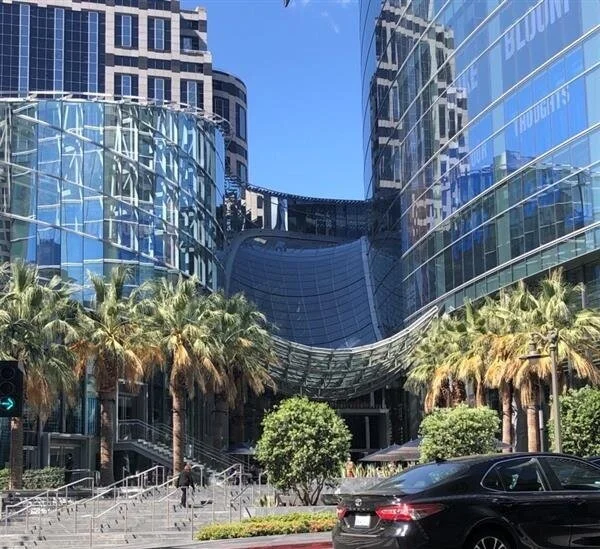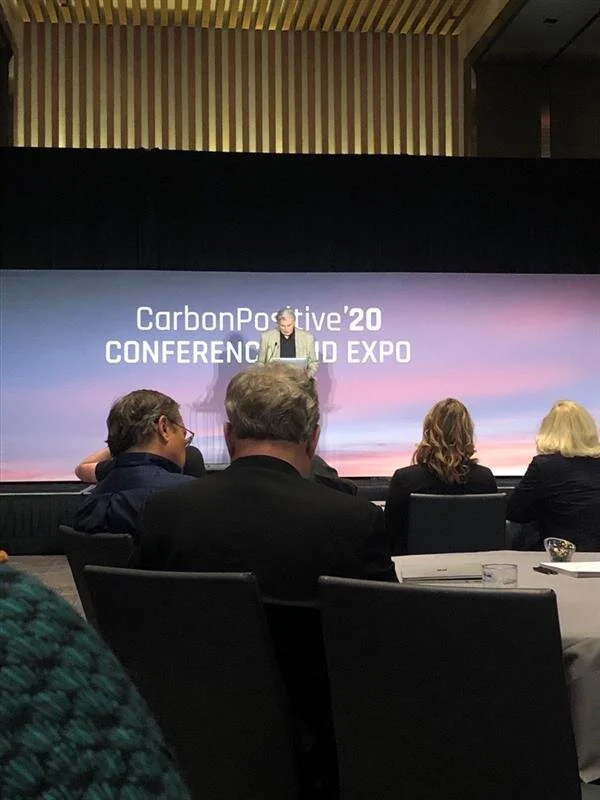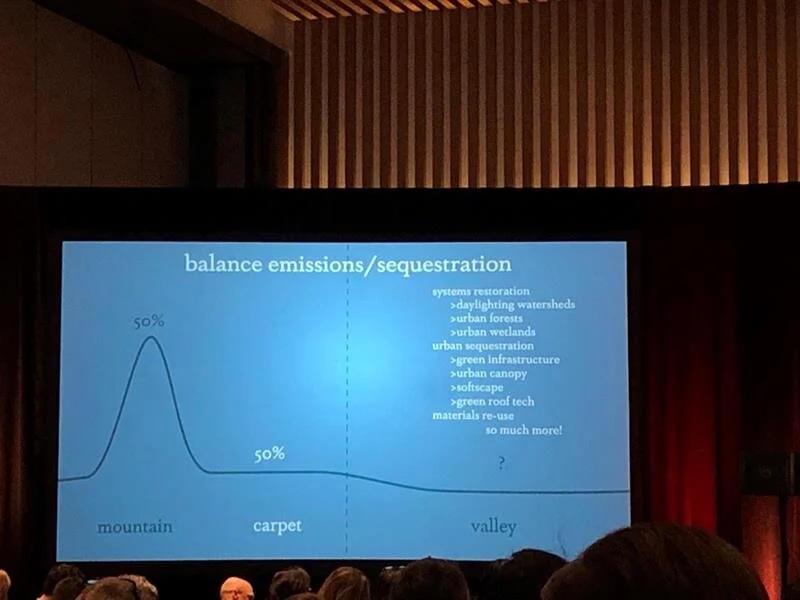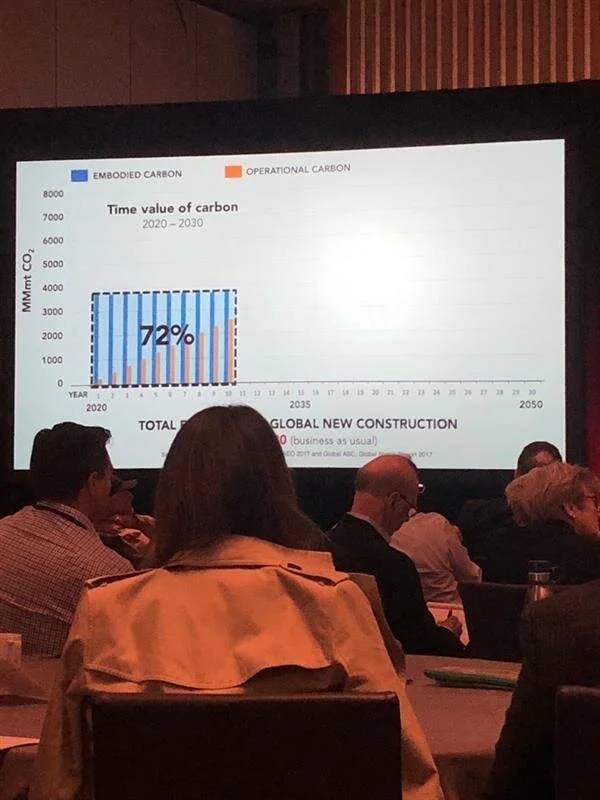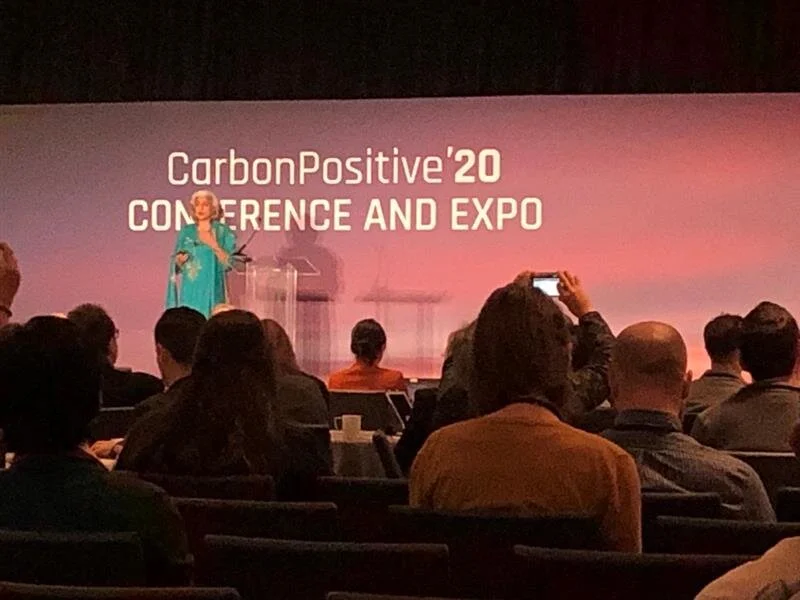Carbon Positive 2020 Recap

Recently, our Research Fellow Kelsey Wotila and Principal/Sustainability Director Z Smith attended the first Carbon Positive Conference and Expo in Los Angeles from March 2-4.
Kelsey presented her fellowship work on the role of MEP systems in a carbon positive future via a session titled the “Interior Dialogue: Material Impact and Innovation,” session. Following is a review of the experience from her:
Located at the Intercontinental in downtown LA, the conference was buzzing with energy. When Ed Mazria took the stage following Ned Cramer for opening remarks, it was an immediate feeling of call to arms among the audience. The two spoke of the need for '“emotional resilience,” in the times of climate change, which spoke directly to me, having learned throughout my time in New Orleans what it means to live in a resilient community. Several messages became persistent threads throughout the conference. First discussed—a need for historical change in architecture policy, something I believe achievable: we’ve seen historic decoupling of emissions and GDP, and we need to push the industry and design profession to create more of this. We need to design efficient buildings, reducing energy demand on the grid, and decarbonize the grid simultaneously. I was shocked, somewhat fearful, but mostly motivated to hear that we need to cap global emissions now. The timeline we have previously held (at least in architecture) is peaking by 2030. As a whole, we haven’t reached these goals, so now the timeline is shortened, the goals made more aggressive, and the risk to reward outcome heightened.
The good news? We have a path forward, courses of action we can take to change the conversation. We know steel, concrete, and aluminum are responsible for “the belly of the beast,” as Ed said. Making up~23% of global emissions, and directly linked to the design and construction of buildings, we have the power to reduce our use and reliance of these materials through structure optimization. Alternative courses of action emphasize reuse of both materials and whole buildings, and carbon sequestration and storage through use of biogenic building materials. We also know how to make all-electric buildings and cut our ties to natural gas, which, when paired with renewables producing our energy, significantly lowers the carbon emissions associated with buildings.
Which leads me to my presentation, a discussion on the EskewDumezRipple project LWCC in Baton Rouge, Louisiana. In case-study format, this project exemplifies several goals of Architecture 2030. We reused an existing building, and made it more efficient through mechanical system upgrades. In general, most architects understand the material savings associated with building renovations. Those savings also mean a reduction in carbon emissions. For this renovation, we “spent” about 12% of the embodied (or upfront) carbon emissions when compared to a comparable building built today.
(left to right) Jennifer Chen, Larry Strain, Chris Magwood, and Kelsey Wotila presenting at Carbon Positive ‘20 in LA.
Our second source of emissions saved came from the mechanical upgrades to LWCC. Mechanical system upgrades and renovation included lighting and changing the air, heating, and cooling distribution system. These upgrades brought the building EUI from a measured 93 to projected 27 kBtu/sf/yr. All prior lighting was removed, and high-efficiency LEDs, occupancy sensors, etc., installed as replacement. For HVAC, all we did was change the air, heating, and cooling distribution system from central station water-source heat pump (WSHP) variable air volume (VAV) air handling units to a new water-cooled heat recovery (using the existing, 1980’s cooling towers) VRF (variable refrigerant flow) system with DOAS. A benefit of DOAS is improved indoor air quality, fine-tuned zoning ability, and increased occupant comfort as a result.
Evaluating the MEP systems for embodied carbon helps us gain a life cycle impact analysis of the renovation. Are the mechanical system upgrades and efficiencies (and therefore operational carbon savings) worth the upfront carbon of the system? In total, the system is about 35 kgCO2e./m2. The result is ~40% of the total renovation embodied carbon impact. We know that building operations play a large role in our emissions, too. From 1984 to 2030, if business went on as usual, the building would emit 140 kgCO2e./m2 annually in operations. The mechanical system upgrades cut operational carbon to about a third of that, from 140 per year to 45 kgCO2e./m2 per year. Including the MEP system embodied carbon, and the interior renovation embodied carbon, in one year, the project emits 135 kgCO2e./m2. With business as usual totaling 140 kgCO2e./m2, that means a carbon payback of one year! Mechanical system upgrades are significantly worth it in a building renovation, especially one that hasn’t seen tenant improvement since it’s original build.
A chart displaying the embodied carbon of the interior renovation of LWCC, including its MEP systems, and the operational carbon associated with business as usual operations (red dashed line) compared to projected operational emissions (in green).
This lesson mirrors several Ed Mazria spoke about. He emphasized the need to focus on the “mountains,” the tall, >50,000 sf buildings in our cities. Carl Elefante and Julia Siple of Quinn Evans spoke of “loving the buildings we have,” and finding excitement and innovation within the constraint of working with existing buildings. The LWCC case study put real world data and cost to these concepts, and is just a sample of more to come on questions about MEP systems and their carbon impact from the “Paths to Carbon Zero” Fellowship!
Carbon Positive encouraged everyone to take action as individuals and as disruptors within their firms and in pushing the industry.
Personally (and inspired by Farhana Yamin of Track 0), my decarbonization plan includes the “five F’s”:
Food - I used to eat ‘meatless Mondays,’ in an attempt to cut back my carbon emissions. I’m not ready to fully cut out beef and poultry, but am moving toward ‘meat Mondays,’ where the majority of my week is dedicated to eating vegetarian.
Fashion - nothing new. Reject fast fashion, borrow, swap, buy second hand. Don’t buy unless you need it.
Flights - I bought carbon offsets for my flights to the conference, and will continue to do so for every flight I take. (Use this calculator, but buy through Gold Standard). When I have the flexibility in time, I’ll opt for driving or the train instead.
Finance - Divest from Fossil Fuels.
Friends - Talk about it. Educate each other. Encourage everyone to take action, and extend that action to their lifestyle and career.
I encourage you to consider yours. This extends to firm practices. As an Architecture 2030 Commitment Signatory, EskewDumezRipple is working to meet Architecture 2030 goals and report our portfolio performance. We need more firms to sign up and share their data, their successes, and their failures, so we can collectively solve this issue of climate to ensure a resilient, beautiful future in architecture.
